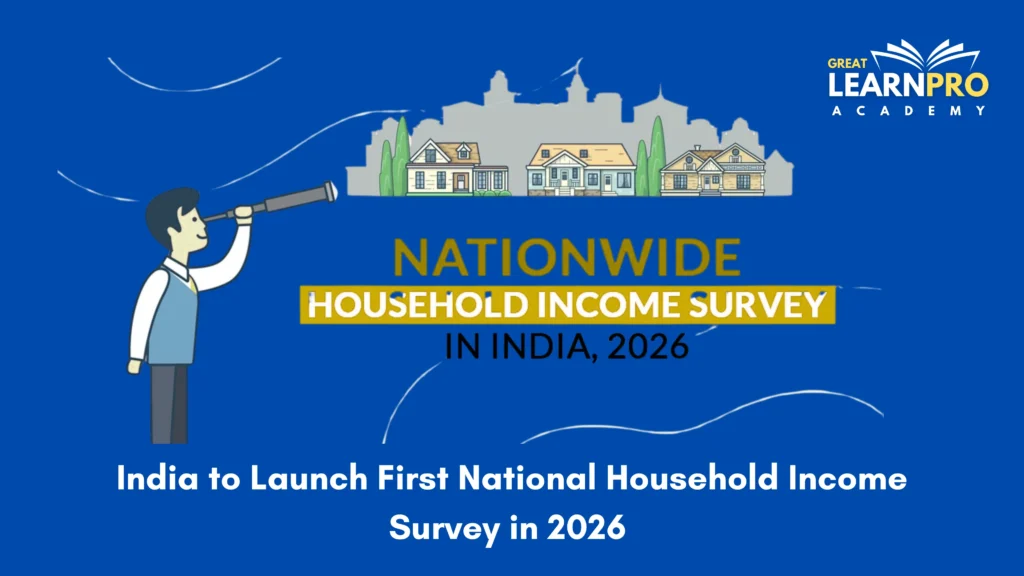The Indian government, through the Ministry of Statistics and Programme Implementation (MoSPI), is preparing to conduct its first full-scale, nationwide National Household Income Survey (NHIS) in February 2026. This marks a major step in India’s data landscape, aiming to accurately measure income distribution, inequality, and the impact of welfare policies. The survey will also help assess how different segments of the population are benefiting from economic growth and government initiatives.

Why It’s Being Done
For decades, India has collected strong data on consumption, expenditure, employment, and demographics through instruments like the National Sample Survey. However, consistent and reliable data on actual household income has been missing. Earlier attempts in the 1950s to 1980s included experimental efforts, but none provided a comprehensive or continuous understanding of income across diverse groups such as rural households, urban workers, informal earners, and salaried employees.
The NHIS aims to fill this long-standing gap. It seeks to provide a detailed and accurate picture of how incomes are earned and distributed, how inequality has changed, and how income sources—ranging from wages and small businesses to self-employment and digital work—are evolving. As India’s economy becomes more digital and diversified, understanding income flows is crucial for shaping welfare schemes, taxation, and employment policies based on evidence rather than estimates.
How It Will Work
A Technical Expert Group (TEG) headed by economist Dr. Surjit S. Bhalla, former Executive Director at the International Monetary Fund, has been constituted to guide the survey’s design and implementation. The panel includes statisticians, economists, and academic experts from leading institutions such as the Indian Statistical Institute, NCAER, JNU, and the University of Hyderabad. Their responsibilities include finalizing definitions, designing questionnaires, and ensuring the data collected is both reliable and comparable across different regions and sectors.
The NHIS questionnaire will cover all possible sources of income: salaries, casual labour, self-employment, farming, small enterprises, and even non-cash income such as goods and services received in kind. A pre-testing exercise of the questionnaire was conducted in mid-2025 across 15 regional offices, covering both rural and urban areas to ensure clarity and respondent comfort. The final survey will then use a scientifically designed sample to represent India’s vast diversity state-wise, region-wise, and class-wise.
Challenges Ahead
While the NHIS is an ambitious and much-needed initiative, it also faces several challenges.
- Data reliability and disclosure concerns:
Many households are hesitant to share details of their income, particularly when it comes from informal or multiple sources. In previous pre-tests, a large proportion of respondents declined to answer questions about income tax or total earnings, citing privacy concerns or mistrust. - Complexity of informal incomes:
A significant part of India’s workforce earns through informal or irregular means small businesses, daily wages, agricultural work, or gig economy platforms. Capturing these diverse and fluctuating income streams will require precise survey tools and sensitive enumerator training. - Under-reporting and bias:
Higher-income respondents may understate their earnings, while others may struggle to recall exact figures. To counter these issues, the survey will rely on anonymized data collection, better question sequencing, and statistical validation. - Regional diversity:
India’s income patterns vary sharply between urban and rural regions, and between agricultural and industrial areas. Ensuring representation across these divides will be critical for meaningful national estimates. - Logistical hurdles:
Conducting a nationwide household income survey across millions of homes requires significant human and financial resources. Field operations, translation, digital data handling, and supervision will all be major challenges.
What It Could Enable
If implemented successfully, the NHIS 2026 will generate the most comprehensive dataset on income inequality ever produced in India. It will allow policymakers to:
- Identify gaps in social welfare coverage and ensure that subsidies, pensions, and cash transfers reach those who truly need them.
- Formulate evidence-based tax policy, helping the government assess income thresholds and tax burdens more accurately.
- Analyze urban-rural disparities and gender income gaps, revealing how income generation opportunities differ across social groups.
- Enable better macroeconomic forecasting, since knowing how real incomes evolve improves projections of consumption, savings, and investment.
- Support academic and policy research on issues such as poverty dynamics, class mobility, and the structural transformation of India’s labour market.
Conclusion
The National Household Income Survey 2026 represents a landmark effort to replace assumptions with data-driven insights about how Indians earn and live. It will shift the focus from indirect consumption-based estimates to real, measurable income patterns. While challenges such as under-reporting, respondent hesitancy, and data verification remain, the initiative marks a turning point in India’s economic policymaking.
If executed with transparency, methodological rigor, and public trust, NHIS 2026 could transform the way India understands its economy revealing the true story behind its growth, inequality, and opportunities for every household.
Sources:
- https://indianexpress.com/article/business/statistics-ministry-first-ever-household-income-survey-2026-10083748/?utm_
- https://economictimes.indiatimes.com/news/economy/indicators/pre-testing-exercise-held-for-new-household-income-survey/articleshow/124535091.cms?utm_
- https://www.business-standard.com/economy/news/nso-household-income-survey-india-2026-mospi-inequality-data-125062300835_1.html?utm_
More Current affairs: https://learnproacademy.in/updates/
